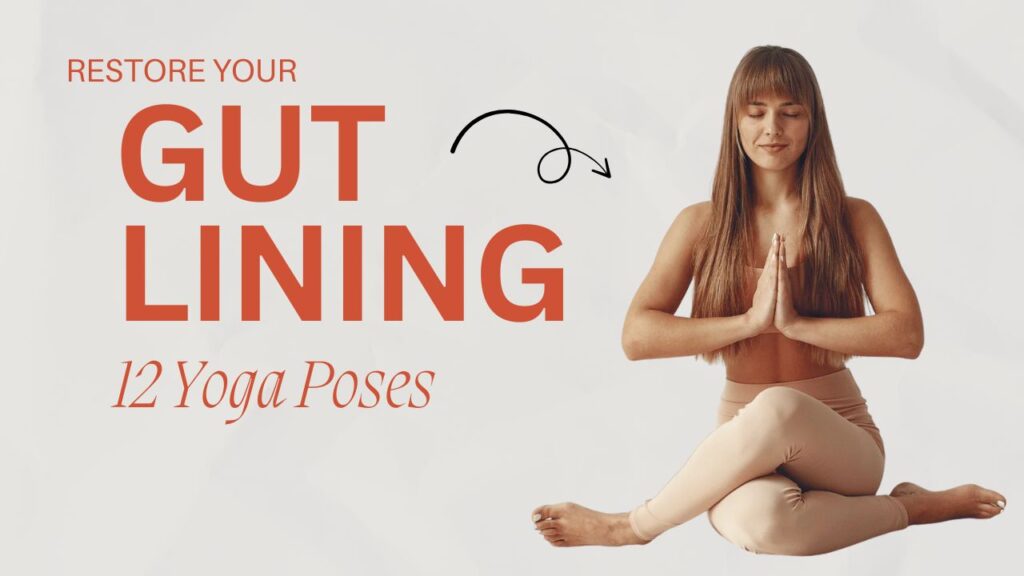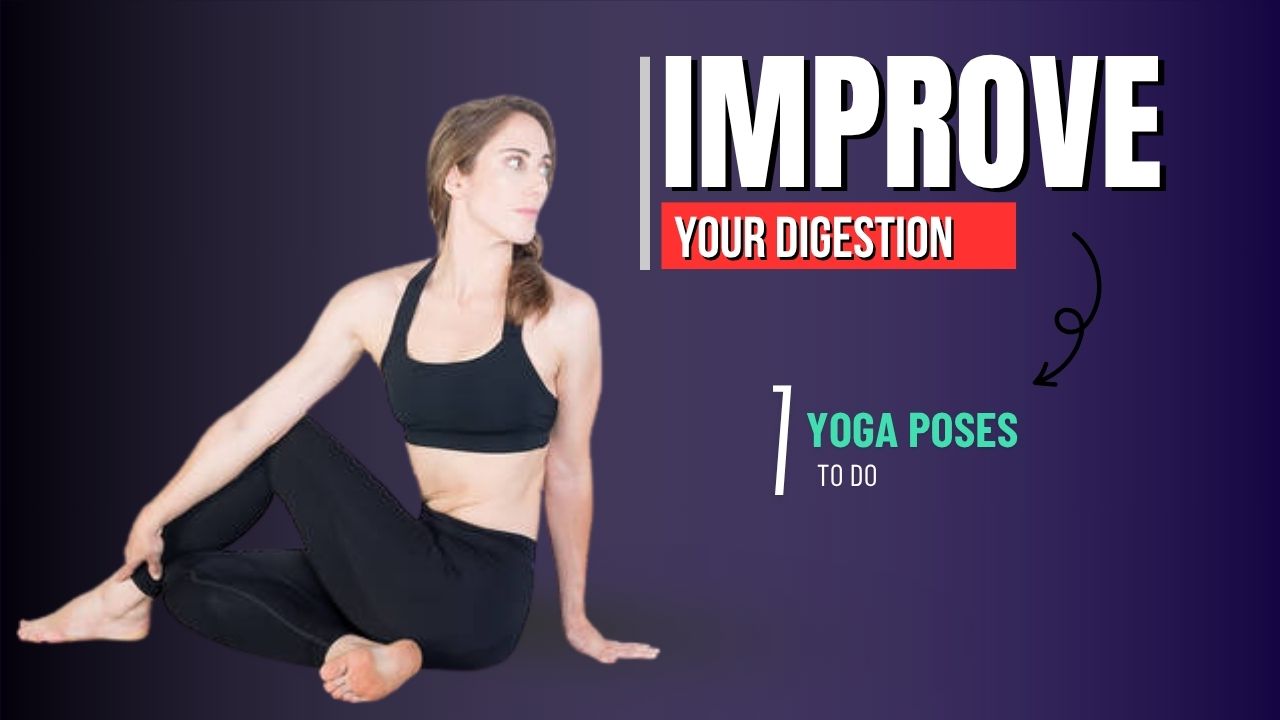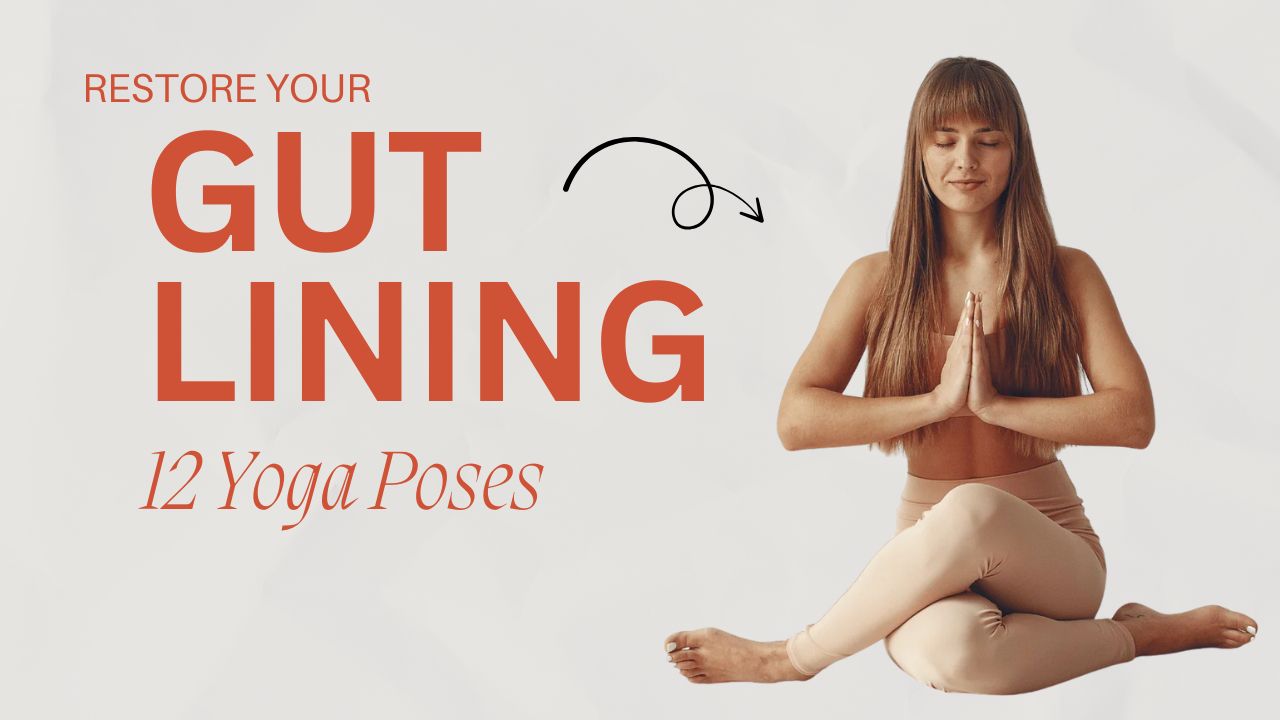Do you know that your gut lining regenerates every 5 to 7 days? But here’s the catch: constant stress, poor posture, and shallow breathing can slow down or even damage this natural healing process.
While supplements and diets often take center stage in gut health discussions, the role of yoga is massively underrated.
Yoga doesn’t just stretch your muscles — it calms your nervous system, stimulates digestion, and promotes circulation to your abdominal organs. In other words, it creates the perfect internal environment for your gut lining to repair and thrive.
In this guide, you’ll learn 12 yoga-based tools — including poses, breathwork, and daily habits — designed specifically to support and restore your gut lining. Let’s dive into how to bring harmony to your body from the inside out.

Table of Contents
What Can Happen After 30 Days of Yoga for Gut Healing
| Positive Changes You May Notice | Why It Happens |
|---|---|
| Reduced bloating and gas | Improved digestive motility and massage of abdominal organs |
| Better bowel movements and regularity | Gentle poses stimulate peristalsis and detoxification |
| Decreased abdominal discomfort | Lowered inflammation and tension in the gut area |
| Improved mood and reduced anxiety | Breathwork activates the parasympathetic (rest & digest) system |
| Enhanced nutrient absorption | Mindful eating and relaxed digestion help your gut process food more effectively |
| Improved sleep and energy levels | Calmer nervous system and better digestion improve rest and vitality |
| Lower stress response | Daily breathwork and gentle movement reduce cortisol levels |
| Better posture and core awareness | Core-focused poses strengthen muscles around the gut |
Do’s & Don’ts for Healing Your Gut Lining with Yoga
| Do | Don’t |
|---|---|
| Practice yoga on an empty or light stomach | Don’t perform intense yoga right after eating |
| Focus on slow, deep belly breathing daily | Don’t rely solely on supplements for gut healing |
| Choose gentle, restorative poses like Child’s Pose and Butterfly Pose | Don’t force deep twists or hold poses that cause pain |
| Be consistent — aim for daily or near-daily practice | Don’t expect immediate results without consistent effort |
| Combine yoga with mindful eating habits | Don’t eat while distracted (TV, phone, etc.) |
| Listen to your body and modify poses when needed | Don’t push through bloating, cramps, or discomfort |
| Create a calm environment while practicing | Don’t practice in a rushed or stressful state |
| End your sessions with relaxation or meditation | Don’t skip the cooldown or rest phase |
12 Yoga Poses That Restore Your Gut Lining
1. Cat-Cow Pose (Marjaryasana-Bitilasana)
How it helps: This dynamic spinal movement massages your digestive organs, improves blood flow to your gut, and stimulates peristalsis (the movement that pushes food through your intestines).
How to do it:
- Start on all fours with wrists under shoulders and knees under hips.
- Inhale as you drop your belly and lift your gaze (Cow).
- Exhale as you round your back, tucking the chin and pelvis (Cat).
- Repeat for 10–15 slow, mindful rounds.
Interesting fact: Gentle spinal movements like Cat-Cow can help reduce bloating and gas by encouraging the digestive system to “wake up.”
2. Seated Spinal Twist (Ardha Matsyendrasana)
How it helps: Twisting massages the abdominal area, compresses the organs to flush out toxins, and improves the mobility of your intestines.
How to do it:
- Sit with legs extended, bend your right knee and cross it over the left leg.
- Place your right hand behind you for support and left elbow outside the right knee.
- Inhale to lengthen your spine, exhale to twist.
- Hold for 5–8 breaths, then switch sides.
Myth buster: Twists don’t “wring out” toxins, but they do increase circulation and aid detoxification via improved digestion and lymphatic drainage.
3. Apanasana (Knees-to-Chest Pose)
How it helps: Known as the “wind-relieving pose”, it gently compresses the colon and small intestine, helping release trapped gas and soothing inflammation in the gut lining.
How to do it:
- Lie on your back, bring both knees into your chest.
- Wrap your arms around your shins.
- Rock slightly side to side.
- Stay here for 1–2 minutes while breathing deeply.
4. Deep Belly Breathing (Diaphragmatic Breathing)
How it helps: Shifting from shallow chest breathing to deep belly breathing activates the parasympathetic nervous system — the state where healing and digestion happen.
How to do it:
- Sit or lie down comfortably.
- Place one hand on your belly, one on your chest.
- Inhale through the nose, allowing the belly to rise.
- Exhale slowly, letting the belly fall.
- Practice for 5–10 minutes daily.
Fact: Belly breathing can increase vagus nerve activity, which is essential for gut motility and reducing inflammation.
5. Bridge Pose (Setu Bandhasana)
How it helps: Stimulates abdominal organs and stretches the spine, promoting circulation to the gut lining.
How to do it:
- Lie on your back, bend knees, feet hip-width apart.
- Press into your feet and lift hips off the ground.
- Interlace hands under your back and open the chest.
- Hold for 30–60 seconds, repeat 2–3 times.
6. Child’s Pose (Balasana)
How it helps: Promotes calm, reduces stress hormones like cortisol (which damages the gut lining), and gently compresses the abdomen.
How to do it:
- Kneel on the mat, bring your big toes together, and spread your knees wide.
- Fold forward with arms extended or by your sides.
- Breathe deeply into your belly for 2–3 minutes.
Note: Practicing this before meals can help stimulate parasympathetic activity, priming your body for digestion.
7. Butterfly Pose (Baddha Konasana)
How it helps: Encourages blood flow to the pelvic region and stimulates abdominal organs.
How to do it:
- Sit tall and bring the soles of your feet together.
- Let your knees drop to the sides.
- Hold your feet and fold forward slightly.
- Stay here for 2–3 minutes, breathing gently.
8. Legs-Up-the-Wall (Viparita Karani)
How it helps: Reduces inflammation and boosts circulation to the gut and pelvic region. Also calms the nervous system.
How to do it:
- Lie on your back and extend your legs up a wall.
- Adjust hips close to the wall.
- Place a cushion under your hips for support if needed.
- Relax for 5–10 minutes.
Did you know? This pose can help lower cortisol levels and support gut lining regeneration during rest.
9. Nadi Shodhana (Alternate Nostril Breathing)
How it helps: Balances the nervous system and reduces anxiety — both crucial for maintaining a healthy gut barrier.
How to do it:
- Sit comfortably with a straight spine.
- Use your right thumb to close your right nostril, inhale through the left.
- Close left nostril with your ring finger, exhale through the right.
- Inhale right, close right, exhale left — that’s one round.
- Repeat for 5–10 rounds.
10. Happy Baby Pose (Ananda Balasana)
How it helps: Opens the hips and compresses the abdomen, promoting digestive health and releasing tension in the lower belly.
How to do it:
- Lie on your back, bend your knees and grab the outer edges of your feet.
- Gently pull your knees toward the floor, keeping ankles over knees.
- Hold for 1–2 minutes while breathing into your belly.
11. Mindful Eating Habit (Yoga Off the Mat)
How it helps: Eating slowly and consciously enhances digestive enzyme release and absorption, which reduces gut irritation and supports lining repair.
How to practice it:
- Eat without screens or distractions.
- Chew each bite thoroughly (20–30 times).
- Notice textures, flavors, and your body’s fullness cues.
- Pause between bites and breathe.
Fact: Digestion starts in the mouth — mindful chewing signals the gut to prepare enzymes and acids efficiently.
12. Morning Gut Ritual: Seated Stillness + Gentle Twist
How it helps: A combination of stillness and movement to awaken the digestive tract first thing in the morning.
How to do it:
- Sit in a cross-legged position upon waking.
- Take 2–3 minutes of deep breathing.
- Gently twist left and right with each exhale.
- Follow with a warm glass of lemon water to stimulate digestion.
Final Thoughts
Restoring your gut lining doesn’t always require fancy supplements or complex diets. With the right movement, breathwork, and mindful habits, your body already has the tools to heal itself.
Yoga offers a powerful, holistic way to address gut health — not just treating symptoms, but creating the ideal environment for deep, lasting repair.
Frequently Asked Questions (FAQs)
Can yoga really heal the gut lining?
Yoga can support the natural healing of the gut lining by reducing stress, improving digestion, and increasing blood flow to the abdominal area. While it may not “heal” severe gut issues alone, it plays a significant supportive role in restoring gut health when combined with proper diet and lifestyle.
How often should I do these yoga poses for gut healing?
You can practice these yoga poses 4–5 times per week, or even daily if done gently. Just 15–20 minutes a day can make a noticeable difference in digestion and gut comfort over time.
Are these yoga practices safe for people with leaky gut or IBS?
Yes, most of these poses are gentle and beneficial for people with leaky gut or Irritable Bowel Syndrome (IBS). However, if you experience discomfort or pain during any pose, it’s best to skip it and consult a healthcare professional.
How long does it take to see results in gut health from yoga?
Many people notice reduced bloating, better digestion, and improved energy within a few weeks. However, full restoration of the gut lining can take several months, depending on individual health conditions and consistency of practice.
Can breathwork alone help with gut issues?
Yes, breathwork like diaphragmatic breathing and alternate nostril breathing help activate the parasympathetic nervous system, which is essential for proper digestion, reduced inflammation, and gut lining repair.
Is it better to do yoga before or after eating for gut health?
For digestion and gut healing, it’s best to practice yoga on an empty stomach or at least 2 hours after a meal. Some gentle poses like Child’s Pose or Deep Breathing can be done 30 minutes after eating to assist digestion.
What else should I do besides yoga to heal my gut lining?
In addition to yoga, focus on an anti-inflammatory diet, manage stress, get enough sleep, avoid processed foods, and consider probiotics (if appropriate). Yoga enhances the effects of these lifestyle changes.










